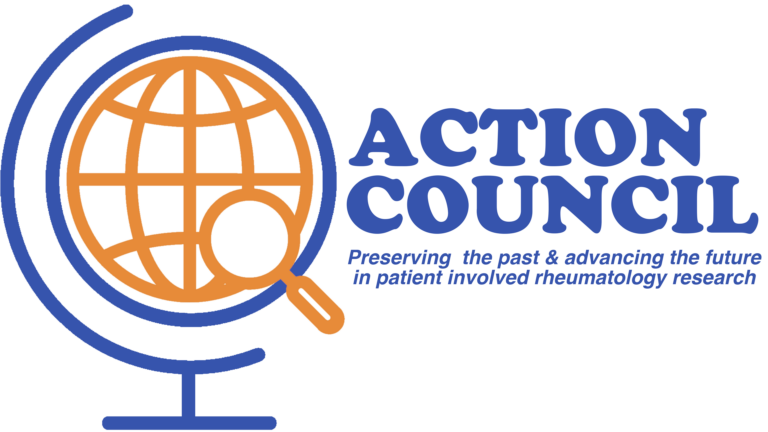TOOLS FOR PATIENT INVOLVEMENT: FRAMEWORKS, GUIDELINES, INSTRUMENTS, RECOMMENDATIONS, REPORTS
Use the Tool Glossary to locate reports of past successes, guidance, and other recommendations for involving patients in *rheumatology research projects.
PLEASE NOTE – The Pathway is a living tool and this initial framework is limited to submissions provided by our original ACTion Council team through December 2020. If you think you have projects, examples, or case studies to submit, please read our submissions guidelines before completing the application.
If you want to learn more about the Glossaries, watch video below:
Frameworks
Authorship
Pathway Stop 2020 – Patients as Co-Authors
- Year 2022: The Patient Author Candidate Framework was developed by Envision Pharma Group as a Patient Authorship Resource for industry sponsors. It is designed to guide assessment of potential patient author candidates, based on a set of transparent, relevant, and pre specified criteria.
Regulatory
Pathway Stop 2015 – Patient Engagement In The Regulatory Process – Tools Emerge In The United States & Europe
- Year 2014 European Medicines Agency (EMA) revises original Patient Organization Collaboration Framework.
- Year 2015 Food and Drug Administration (FDA) publishes Patient Preference Information (PPI) frameworks to describe patient engagement with patients providing advice relating to medical devices.
- Year 2017 EMA involves young people in their activities and establishes the principles for the involvement of young patients, consumers, and their care partners, in the Agency’s scientific committees and working parties in a consistent and efficient manner.
Guidance Documents
Authorship
Pathway Stop 2020 – Patients as Co-Authors
- Year 2020: Researchers and patient partners from the Strategy for Patient-Oriented Research Chronic Pain Network co-wrote guidance to help others talk about authorship and acknowledgement for the research projects they are working on together.
Briefing notes
Pathway Stop 2010 – Experience Working With Patients in Research Leads To Guidance For Best Practices
- Year 2012 INVOLVE publishes updated briefing notes for researchers, revised from 2004.
Ethics
Pathway Stop 2015 – Additional Frameworks and Recommendations for Including Patients in Research
- Year 2018 Canadian Institute of Health Research (CIHR) publishes draft Ethics Guidance for Developing Research Partnerships with Patients.
- Year 2019 ESCEO (European Society for Clinical and Economic Aspects of Osteoporosis, Osteoarthritis and Musculoskeletal Diseases) & World Health Organization (WHO) publish “Best practice principles for engaging patients in health research, treatment guidelines and regulatory processes”
Patient-Researcher Engagement
Pathway Stop 2005 – Rheumatology Guidance Begins
- Year 2005 Cochrane Musculoskeletal develops guidance for systemic review and for building partnerships
Pathway Stop 2010 – Experience Working With Patients in Research Leads To Guidance For Best Practices
- Year 2011 EULAR develops patient engagement Reference Cards and Background document
Pathway Stop 2010 – As The Value Of Patient Engagement Evolves, So Does Guidance And Outcome Focus
- Year 2014 SPOR publishes a Resource Guide for Research Teams and Networks
Pathway Stop 2015 – Additional Frameworks and Recommendations for Including Patients in Research
- Year 2019 INVOLVE produces a set of six draft Standards for Patient Engagement
Pathway Stop 2020 – Patient Led Guidance to Help Researchers Improve Collaboration
- The Saskatchewan Center for Patient-Oriented Research (SCPOR) creates a guide for researchers to consider when starting a patient-oriented research project.
Pathway Stop 2020 – Patient Involvement in Basic Rheumatology Research
- Year 2022 A study by the department of rheumatic diseases of the Radboud University Medical Center, which included thirteen Patient Research Partners (PRPs) explored good working models and impact of patient involvement in basic rheumatology research and to identify barriers and facilitators (report). Associated road map for patient involvement in basic research also provided.
Patient-Focused Drug Development
Pathway Stop 2015 – Establishment And Evolution Of The Patient-Focused Drug Development Initiative
- Year 2018 FDA develops PFDD guidance materials
- Year 2019 FasterCures publishes a guide for patient advocacy organizations
Regulatory
Pathway Stop 2015 – Patient Engagement In The Regulatory Process – Tools Emerge In The United States & Europe
- Year 2017 FDA / CTTI Develops guidance materials for R&D continuum
Pathway Stop 2015 – Additional Frameworks And Recommendations For Including Patients In Research
- Year 2019 ESCEO & WHO publish “Best practice principles for engaging patients in health research, treatment guidelines, and regulatory processes”
Value-Based Healthcare
Pathway Stop 2015 – Value-Based Health Care
- Year 2019 ICHOM unites international working group to develop Inflammatory Arthritis Standard Set
Instruments
Patient Engagement
Pathway Stop 2010 – Formal Training Of Patients To Be More Active In Research Begins With EUPATI
- Year 2014 EUPATI Patient Expert Training Courses.
Pathway Stop 2015 – Establishing Measurements Of Effective Patient Engagement
- Year 2018 Arthritis Research Canada (ARC) introduces the Patient Engagement in Research Scale (PEIRS)
Patient- Researcher Engagement
Pathway Stop 2015 – Additional Frameworks, Recommendations, And Reviews
- Year 2016 EUPATI offers the Toolbox on Medicine Research & Development and Patient Engagement
Pathway Stop 2020 – 1st Scientific Session at ACR to Assist those Designing Patient-Included Rheumatology Research Projects
- Year 2022 The ACR Convergence meeting features the 1st scientific session of its kind to help attendees improve patient involvement as partners in their research projects. Presentation of this Pathway of Patient Engagement in Rheumatology Research Tool designed by the ACTion Council.
Outcomes Research
Pathway Stop 2015 – Additional Frameworks, Recommendations, And Reviews
- Year 2015 EULAR develops Health Related Quality of Life Instrument (RAID) and (PsAID)
Recommendations
Clinical Trial Engagement
Pathway stop 2015 –Pharmaceutical Companies Get More Involved In Patient Research Collaborations
- Year 2015 Clinical Trials Transformative Initiative (CTTI) develop recommendations regarding ways patients groups (i.e., patient and disease advocacy organizations, voluntary health organizations, nonprofit research foundations, public health organizations) could be engaged in the therapy development process, particularly around clinical trials.
Compensation
Patient Stop 2015 – Compensating Patient Partners – Guidance Emerges
- Year 2019: National Health Council (United States) publishes a Fair-Market Value (FMV) Calculator to determine compensation based on level of expertise.
- Year 2020: Canadian Arthritis Patient Alliance (CAPA) and the Rare Disease Foundation (Canada) publish additional practical recommendations related to compensation for Patient Research Partners (PRPs).
Dissemination
Pathway Stop 2005 – Rheumatology Guidance Begins
- Year 2008 ASAS/EULAR collaborated with patients to translate recommendations for the management of ankylosing spondylitis (axial spondyloarthritis)
Patient-Researcher Engagement
Pathway Stop 2010 – Experience Working With Patients in Research Leads To Guidance For Best Practices
- Year 2010 With OMERACT, EULAR publishes recommendations for patient-researcher collaboration
Pathway Stop 2015 – Additional Frameworks, Recommendations, And Reviews
- Year 2015 OMERACT publishes recommendations for collaborative research
Reports
Dissemination
Pathway Stop 2010 – As The Value Of Patient Engagement Evolves, So Does Guidance And Outcome Focus
- Year 2013 – PCORI Matching Actions to Needs: What Matters Most to the Arthritis Community? [PCORI, Arthritis Foundation]
Health Equity
Pathway Stop 2020 – Health Equity And Diversity, Front And Center Year 2020 [COVID19 Global Rheumatology Alliance, Research Abstract]
Patient Engagement
Pathway Stop 2010 – Opportunities for Patient Involvement in Advisory Panels Expands
- Year 2011 PCOR projects that included rheumatology patients in research [PCORI]
Pathway Stop 2015 – Pharmaceutical Companies Get More involved in Patient Research Collaborations
- Year 2015 A Community Team (ACT) project, patient-led initiative to unite all stakeholders in research to improve outcomes [International Foundation for Autoimmune & Autoinflammatory Arthritis (AiArthritis)]
Pathway Stop 2015 – Rheumatology Scientific Meetings Continue To Unite Researchers, Rheumatologists, And Patients
- Year 2017 EULAR Standing Committee of People with Arthritis/Rheumatism in Europe (PARE) initiate the EULAR study group for collaborative research.
Establishment And Evolution Of The Patient-Focused Drug Development Initiative
- Year 2016 Voice of the Patient report – Psoriasis [National Psoriasis Foundation]
- Year 2017 Osteoarthritis (OA) Voice of the Patient Report [Arthritis Foundation]
- Year 2018 Lupus Patient Voices Report [Lupus and Allied Diseases Association, Lupus Research Alliance, Lupus Foundation]
Patient- Researcher Engagement
Pathway Stop 2002 – Patients are Invited to Join the Rheumatology Research Team
- Year 2002 Read more about the initial history of patient involvement at OMERACT
Pathway Stop 2010 – Experience Working With Patients in Research Leads To Guidance For Best Practices
- Year 2010 University of the West of England publishes a dedicated paper on patient-researcher collaboration in dev. Of a new patient-reported outcome (PRO) for fatigue in RA (BRAF).
Pathway Stop 2010 – Focus on Expanding PCOR Leads To The Established Of Collaborative Communities – United States (Change to Establishment)
- Year 2013 Overview document to learn more about Patient- Powered Research Networks (PPRNs)
- Year 2015 Overview of PPRN ArthritisPower
- Year 2015 Summary of PPRN PARTNERS
- Year 2015 Assessment of PCORnet
Pathway Stop 2020 – Patient Involvement in Basic Rheumatology Research
- Year 2022: A study by the department of rheumatic diseases of the Radboud University Medical Center, which included thirteen Patient Research Partners (PRPs) explored good working models and impact of patient involvement in basic rheumatology research and to identify barriers and facilitators (report).

